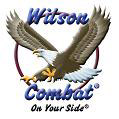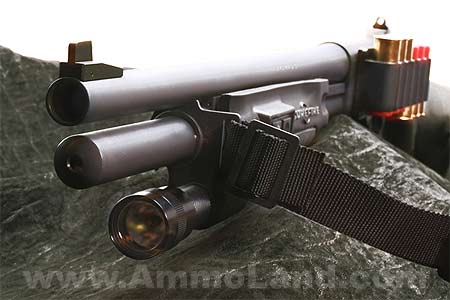The Shotgun Has A Place In Your Toolbox – Part Two
Article By Rob Haught (Part One)


Berryville, AR – -(AmmoLand.com)- In this second article dealing with Shotguns, I would like to go into my personal preferences in setting up a defensive Shotgun and why I choose the accessories that make up the “Rob Model”. I’m often asked during shotgun programs why I have a particular accessory bolted to my gun and over time it has morphed into what I refer to as the “Rob Model”.
It’s probably appropriate to go back to the genesis of the modern social shotgun and see how these things developed. In the 80”s the American Pistol Institute, now known as Gunsite began the first real development of the “Social Shotgun”. Basically they took a standard Police duty shotgun and added a sight system that allowed the use of both slugs and buckshot to an acceptable level. The Ghost Ring sight system that we all are familiar with today came about as a result of experimentation there. Also developed was the widespread use of the butt cuff shell holder and several custom holster makers started offering it in their catalogs.
The Sidesaddles originally came only in the six round versions. My good friend John Markwell was the first person I know of who cut them down to hold three shells and gave room to grasp the receiver during manipulations and we all used these until factory four shell models became available and were workable. Magazine extensions were offered as a “Police Only” option from Remington but it seemed everyone had them. Various sling options were used with the standard straight strap; three point and tactical slings were unheard of at the time. One of the popular mods of the day was an attachment point at the pistol grip which allowed taking a knee without the muzzle hitting the ground when performing a weapon transition.
Barrel technology was in its infancy as well, with different options of choking being used. Then along came a crazy Swede named Hans Vang who set the world on its ear with his Vang Comp barrels. Later on came the Rem Choke system and factory options but early on it was Improved Cylinder only. Wooden stocks were only available in one size. It wasn’t until years later that the synthetic stocks in different lengths became an option. Most of what we now see as technique and types of setups can trace their roots directly to Gunsite. About this time a company in Brentwood TN, named Scattergun Technologies
Choke system and factory options but early on it was Improved Cylinder only. Wooden stocks were only available in one size. It wasn’t until years later that the synthetic stocks in different lengths became an option. Most of what we now see as technique and types of setups can trace their roots directly to Gunsite. About this time a company in Brentwood TN, named Scattergun Technologies came on the scene. This was the first place to offer a one stop source for a tactical oriented shotgun. They were extremely popular and were the basis for what we now recognize as the typical setup. Wilson Combat® purchased Scattergun Technologies
came on the scene. This was the first place to offer a one stop source for a tactical oriented shotgun. They were extremely popular and were the basis for what we now recognize as the typical setup. Wilson Combat® purchased Scattergun Technologies and it became part of the Wilson Combat family and continues to evolve the state of the art in tactical shotguns to this day. Having used the original Scattergun line of weapons quite a bit I was very exited when they became part of Wilson Combat and have been involved with the line since then as a consultant and end user in my work and training business.
and it became part of the Wilson Combat family and continues to evolve the state of the art in tactical shotguns to this day. Having used the original Scattergun line of weapons quite a bit I was very exited when they became part of Wilson Combat and have been involved with the line since then as a consultant and end user in my work and training business.
One thing to remember is that all this took place before the carbine came into the widespread use that we see today. The shotgun was pressed into the dual role of scattergun and short range rifle. At the time a battle rifle was a 308 and the AR-15 was most commonly found in its full size variant and was considered too powerful for general LE use. A 12 ga. Slug was the preferred option for shorter range conflict resolution and the Ghost Ring sight allowed a competent operator to engage man sized targets out to 75-100 yards and reasonable speed in using buckshot.
That’s why I have always referred to it as a compromise sight. It gives most of the speed of a bead sight and most of the precision of rifle sights. The shotgun’s biggest rival was the submachine gun and at distances past about 50yds the shotgun slug was superior. Today the Subgun has faded into the shadows with the development of the carbine but for some reason the shotgun simply refuses to die off.
With all the above in mind, I have taken what I feel is the best of the past and added a few twists of my own to the way I like to set up my shotgun. Let’s start from the ground up.

First is the stock, I find the factory standard of 14” to be too long for most folks. I prefer a short 13” “youth” stock. This allows for more movement around body armor or load bearing gear as well as winter clothing. Most folks can manage a shorter stock better that one that is too long. As in most things in life an inch makes a big difference. I use a large head safety. Some swear by them, some at them. I find with gloves they are easier to hit under stress.
As I mentioned before I prefer a short Sidesaddle. This is due to the balance point of the shotgun being located at the receiver. With the longer version I can’t get my hand around the receiver and the gun is awkward during reloading and other manipulations. As far as forearms go, I feel a weapon mounted light is absolutely vital on a defensive weapon. The gold standard is the Surefire® model. They have never let me down.
When it comes to magazine extensions, I prefer a simple one round model. Yes I can hear the clamor now about how the shotgun is way behind the curve on ammo capacities anyway so why not opt for six or eight rounder? It’s simple, balance; a muzzle heavy shotgun is not a balanced shotgun and is both harder to index on target and fatiguing to carry around and manipulate. A one round extension allows me to have one round of dead air space in the tube for slug transitions. Otherwise I wouldn’t personally use one at all. I also like a high visibility follower that I can tell at a glance the state of readiness of the shotgun.
That brings us to barrels, shotgun barrels are like ladies, and no two are alike. Give me a pile of barrels from the same manufacturer and you will find some that shoot better than others with different ammo and some that are just plain good with whatever you put through them. Perhaps no greater development in the shotgun field has taken place in recent years than that of barrel technology and ammunition development. No one ever asked the ammo manufacturers to tighten patterns until recently. Now we have several new types of buckshot that perform like a Vang Comp from a standard barrel. That being said I am a fan of Vang Comp Barrels. Legal length is 18” unless you go through the Class 3 process so I have standardized on this for the “Rob Model”.
Sight wise, I have taken the proven Ghost Ring design and added my personal touch. I cut the ring in half creating a large “U” notch which I have dubbed the “Friendly Ghost”. It gives a very fast presentation and still gives enough reference for slugs out to about the same distance you get from a full circle. The modification can be had from Scattergun Technologies on request. Slings are useful when using the long gun in conjunction with a support weapon. For a home defense scenario I leave them off. Whether you opt for a three-point, two-point or single point is a matter of personal choice and will be dictated by your mission. Rounding off the “Rob Model” is an Armor Tuff finish that helps keep the gun from suffering from rust and offers a slick internal surface to help the gun run smoothly. So to sum up the “Rob Model”, you will end up with an Remington® 870 with a short stock to allow smooth presentations in all situations, a light to identify threats, a sight system that gets the most out of the full range of ammo types, a spare ammo carrier that allows manipulations of the gun to be performed smoothly and a simple mag extension that doesn’t unbalance the weapon and allows for rapid change of ammunition types to respond to changing circumstances. Top this off with a sling system to suit your mission and a finish that will protect the gun from corrosion and you have what I have come to believe is a model that optimizes the modern social shotgun.
Rob Haught:Veteran Law Enforcement Officer
Firearms Trainer for civilian, law enforcement and military
IDPA National Champion
About:
At Wilson Combat we’re proud of our position as the acknowledged leader in customer satisfaction and quality products. We work hard to maintain the reputation we’ve built over almost thirty years, and continue to invest in the human resources, training, capital equipment, research and development to stay on top. We have added new leadership personnel in engineering, manufacturing management, materials, research, design, operations, and business development. One of our goals is to be a little better every single day, and we work hard to meet that goal.
